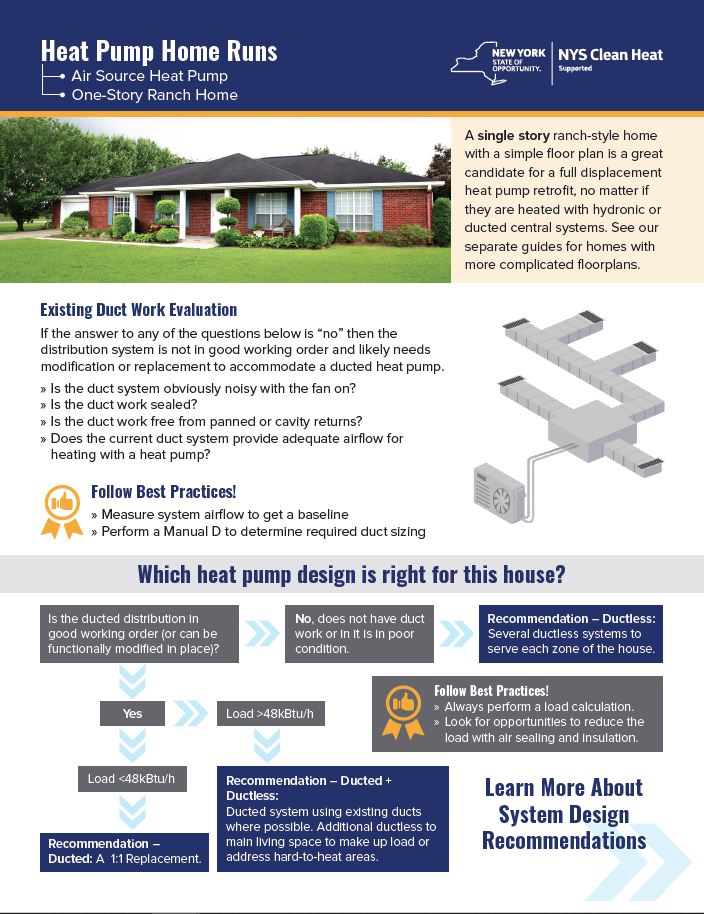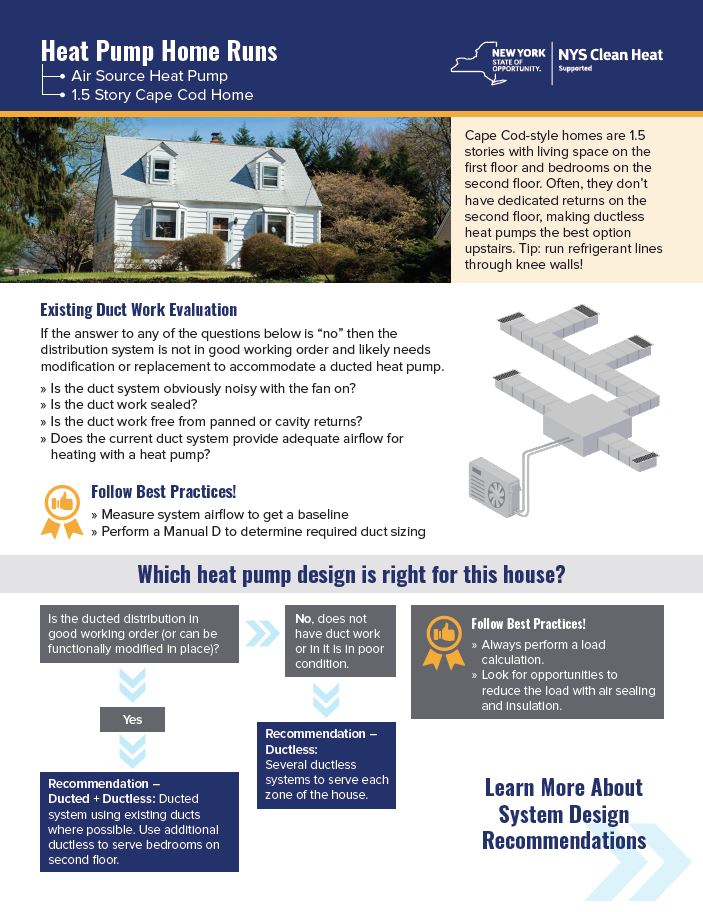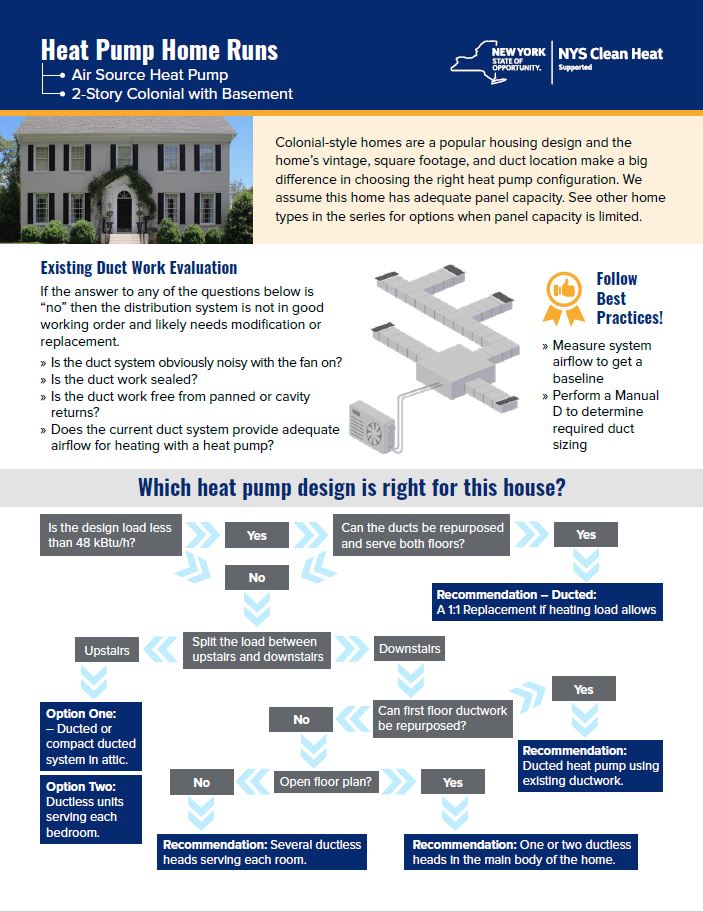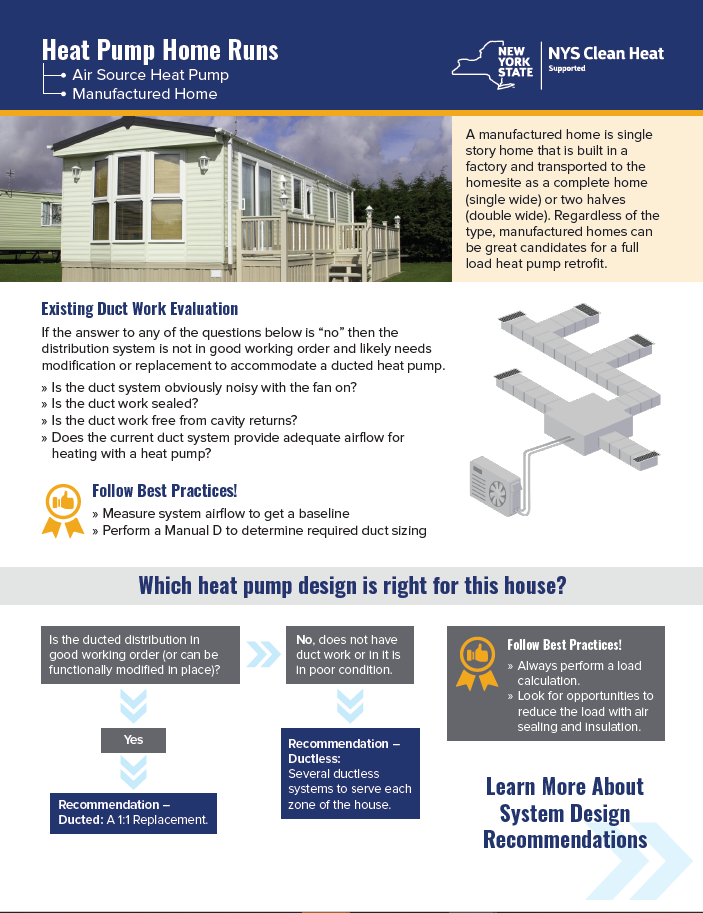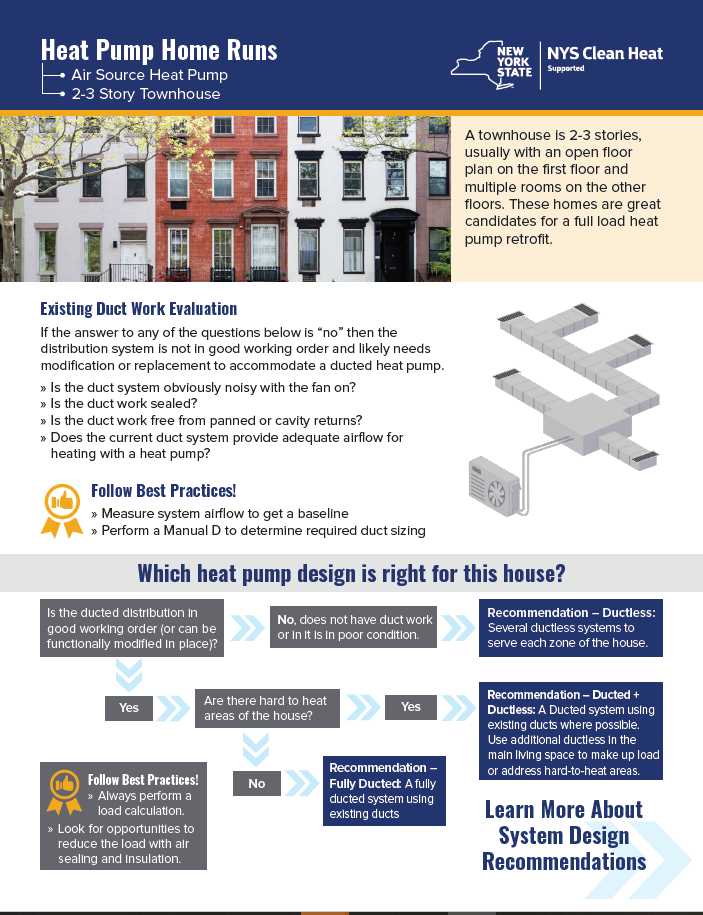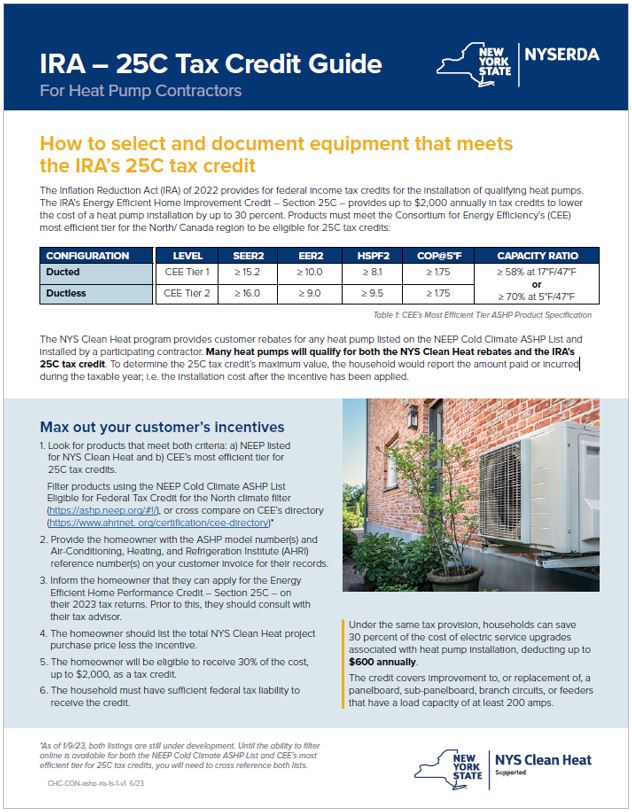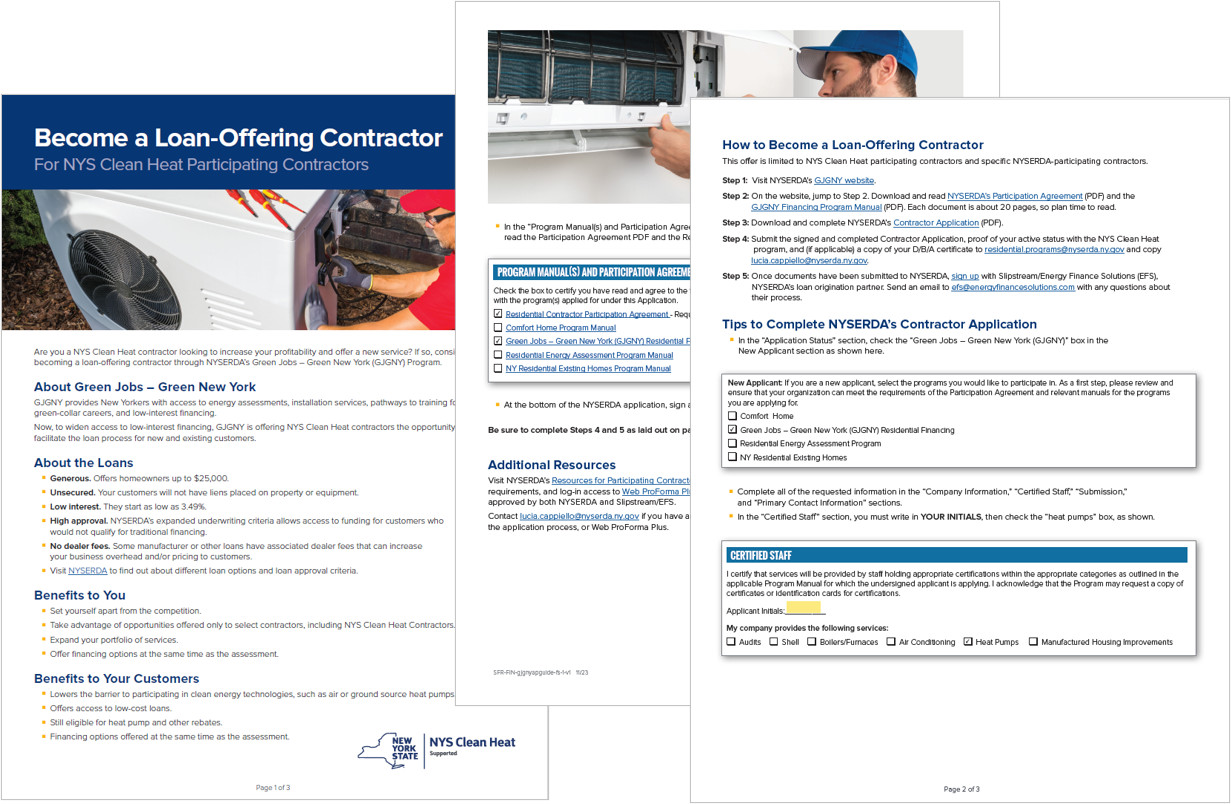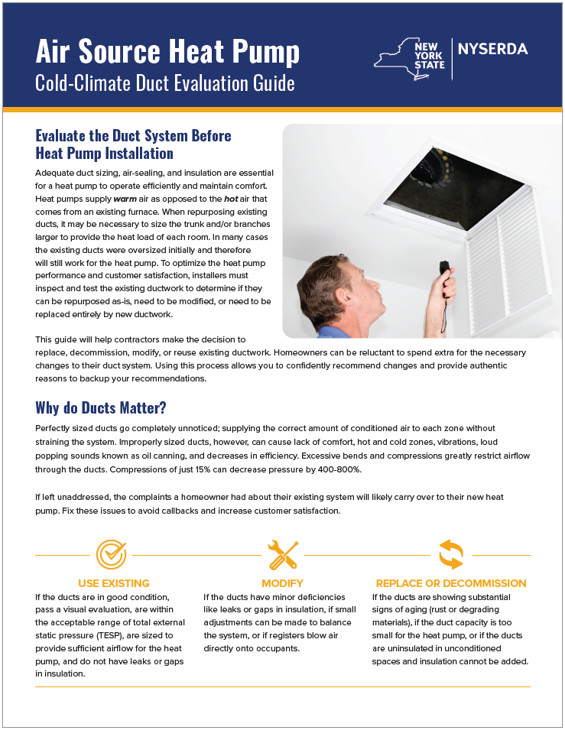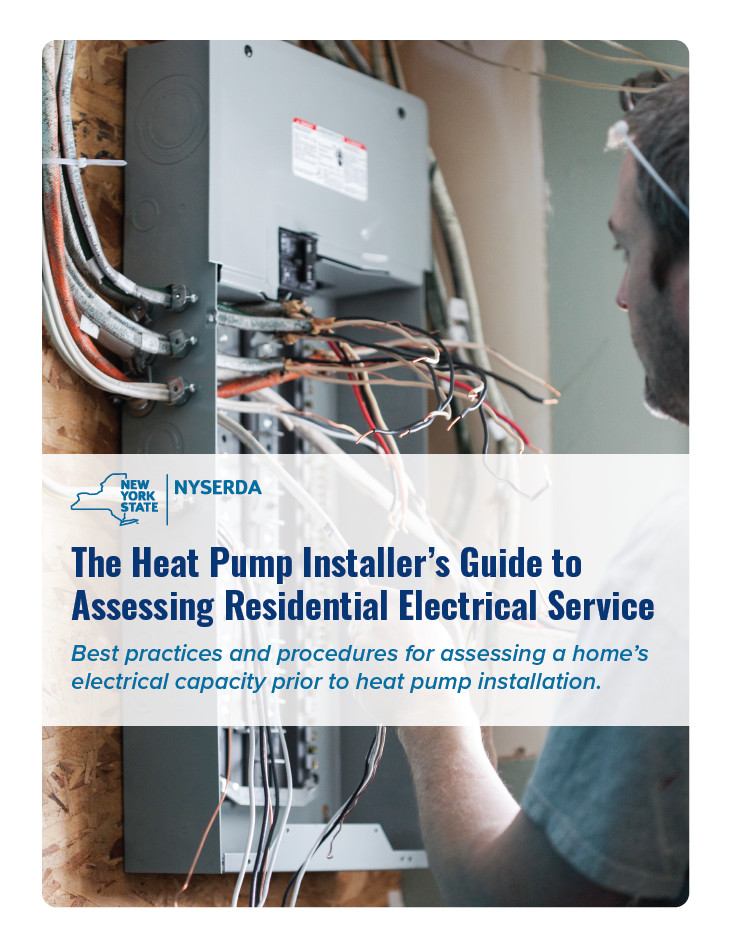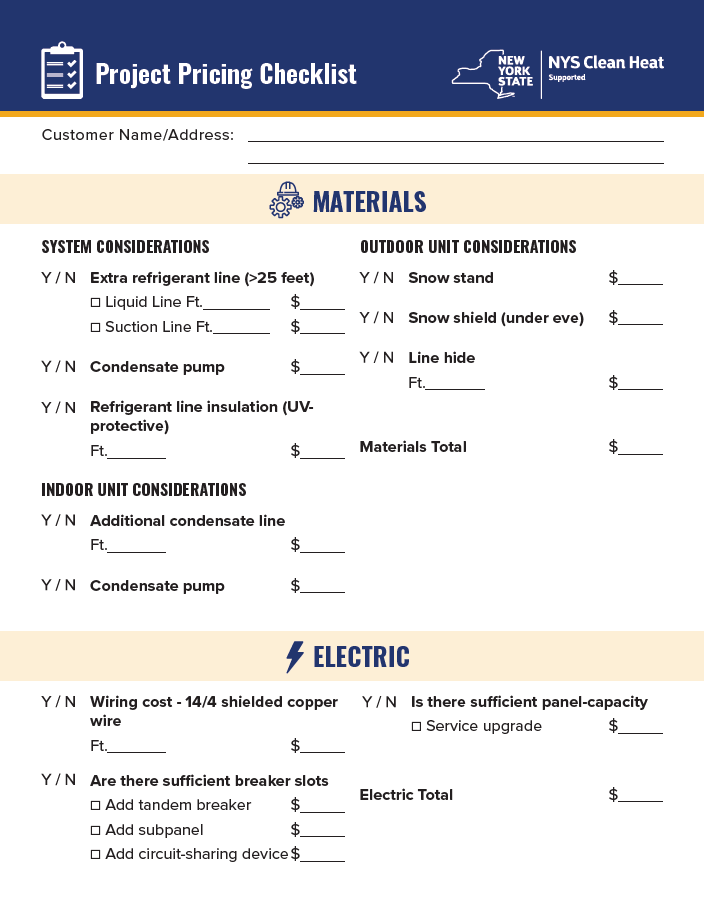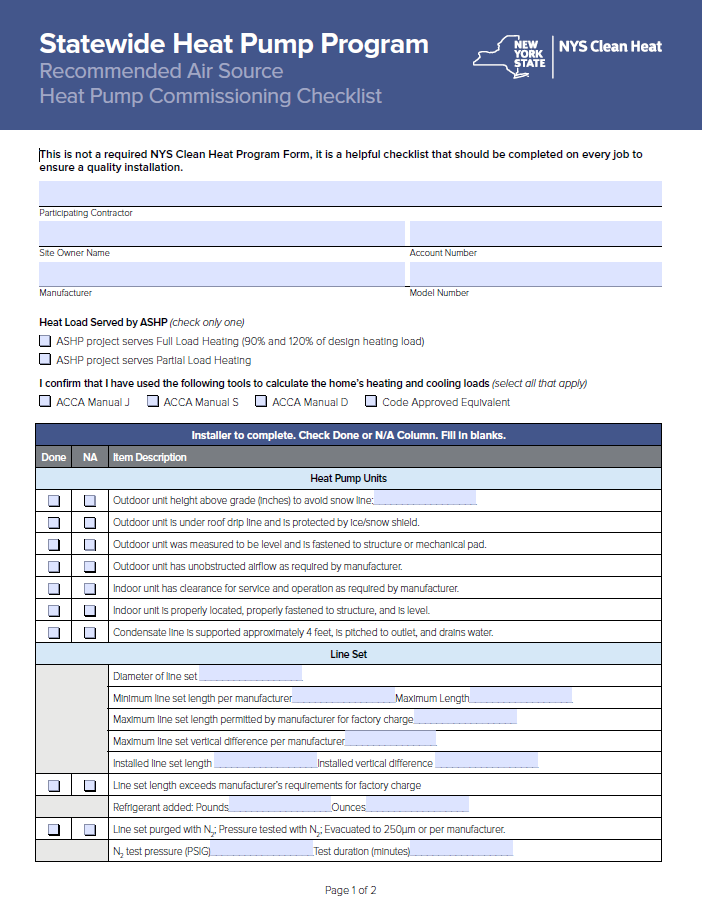Installer Reference Materials
Explore This Section
Review these resources to select the right heat pump for the job and install it for efficient operation and customer satisfaction.
- Heat Pump Home Runs
- IRA – 25C Tax Credit Guide
- Air Source Heat Pump: Efficiency Ratings Explained – DOE Appendix M1
- NYSERDA Workforce Development Opportunities
- Green Jobs - Green New York Financing
- Heat Pump Planner
- Don’t Oversize
- ASHP Cold-Climate Duct Evaluation Guide
- Installer’s Guide to Assessing Residential Electrical Service
- Project Pricing Checklist
- NEEP — Cold Climate Sizing Support Tools
- NEEP — Sizing and Selection ASHP in Cold Climates
- NEEP — Installing ASHPs in Cold Climates Guides
- ASHP Commissioning Checklist
- Snow Deflector Products
- Flare Fitting
Heat Pump Home Runs
Heat Pump Home Runs is a set of winning design strategies for full displacement heat pump installations. Contractors can view heat pump design options for various common home types and be reminded of key technical considerations to review on each job.
IRA – 25C Tax Credit Guide for Heat Pump Contractors
Max out your customer’s incentives by using both NYS Clean Heat program incentives and the IRA tax credits. The IRA – 25C Tax Credit Guide explains equipment eligibility requirements for the Inflation Reduction Act’s (IRA) heat pump tax credits and how they can stack with NYS Clean Heat incentives.
Air Source Heat Pump: Efficiency Ratings Explained – DOE Appendix M1
The Air Source Heat Pump: Efficiency Ratings Explained – DOE Appendix M1 sheet explains the new efficiency metrics (HSPF2, SEER2, and EER2), the new test procedure they came from, and how these changes impact eligibility for NYS Clean Heat utility incentives and 25C federal tax credits from the Inflation Reduction.
NYSERDA’s Funding Opportunities for Workforce Development
NYSERDA’s Clean Energy Workforce Development program supports heat pump installers and distributors looking to grow their businesses. While there are several programs available, the following are the most frequently used by clean heat businesses:
- Wage subsidies for interns and full-time hires
- Support finding new employees through the New York State Department of Labor
- Cost-share for clean heat advertising
- Cost-share for clean heat training, equipment, or training centers
Partners of the Clean Heat Connect network receive focused support navigating these programs and following through on the application requirements. Review the quick guides below for an outline of the program offerings, application steps, program requirements, and an overview of the eligible reimbursements.
Green Jobs - Green New York Financing
As a New York State Clean Heat contractor, you are eligible to take advantage of the Green Jobs - Green New York (GJGNY) Financing. GJGNY Financing offers loans that have low interest rates, are unsecured, have high approval rates, and there are no dealer fees. Becoming a GJGNY loan-offering contractor provides benefits to you and your customers:
- Set yourself apart from the competition.
- Take advantage of opportunities offered to NYS Clean Heat contractors and PSEG electrical customers.
- Expand your portfolio of services without expanding your staff.
- Offer financing options at the same time as the assessment.
Review the fact sheet for an outline of GJGNY Financing and application steps.
Heat Pump Planner
The NYSERDA Heat Pump Planner can be used to show customers how heat pumps might look in their home. The full planner shows multiple housing types. It’s best used as an introductory tool to show the different indoor unit possibilities and configurations.
- Download the full Heat Pump Planner (PDF) (28MB)
- Visit NYSERDA’s Heat Pump Planner webpage to view interactive sections of the Planner and share educational content with your customers.
Don’t Oversize
Oversizing a heat pump is more problematic than oversizing a fossil fuel furnace or boiler. The energy and comfort impacts of an oversized air-source heat pump can take effect beginning with systems sized at 120%, and severe impacts of oversizing can begin with systems sized above 150% of the building load. At a certain point, the system may be unable to achieve heating or cooling entirely. In cold-climates with humid summers a system that’s oversized for heating may be unable to functionally dehumidify the air which can lead to mildew, mold, and wood-rot in extreme cases. In all, oversized systems are costly to the homeowner and reduce comfort.
Air Source Heat Pump Cold-Climate Duct Evaluation Guide
The ASHP: Cold-Climate Duct Evaluation Guide explains why it is important to properly size ducts for air source heat pumps, how to assess existing ducts to determine if they should be reused, modified, replaced, or decommissioned, impacts on duct replacement costs, and best practices when assessing existing ducts. The guide also provides the National Comfort Institute’s (NCI) Standardized Duct Sizing Tables for easy of referencing.
Installer’s Guide to Assessing Residential Electrical Service
Do You Have Enough Juice
When installing a new heat pump system, the home must have sufficient electric system capacity to provide the heat pump’s power. Underserviced homes may require an amperage upgrade from the utility. In many cases the homeowner can avoid this cost by installing technology alternatives that reduce peak amperage, efficiently utilizing breaker space in the electric panel, adding subpanels, or some combination thereof. This moment of decision on how to adapt or update a home’s electrical capacity is a prime opportunity for heat pump contractors to discuss long-term plans with the homeowner and gain momentum toward full electrification, preventing homeowners from having to make additional expensive electrical changes down the line.
This guide will assist HVAC installers in assessing a home’s electrical system before engaging with an electrician or starting the heat pump installation process. This guide includes steps to:
- Determine the home’s electrical service capacity
- Discuss long-term plans for the home
- Estimate existing and future peak electrical loads
- Provide options to install clean heat in electric-system-constrained homes
- Anticipate the electrical work
Project Pricing Checklist
This Project Pricing Checklist, geared towards newer heat pump installers, guides the user to include ancillary items in their installation planning and work-bid. This includes items such as snow-stands, snow-shields, line-hide, and refrigerant line protection.
NEEP — Cold Climate Heat Pump Sizing Support Tools
The cold climate heat pump sizing support tools help users to select cold-climate air source heat pump (ccASHP) products that are sized to best match the peak and annual heating needs of a home or heating zone. The tools, functioning within the NEEP ccASHP Product List website, include a search function and a product-level analysis. The search function helps users compare multiple products based on the search criteria. The product view displays system and load-matching data, and provides a visual for how a specific heat pump’s capacity matches the heating load across the home’s winter temperatures.
NEEP — Sizing and Selecting Air Source Heat Pumps in Cold Climates
Selecting the right cold climate heat pump requires careful consideration of the heating load, the intended use of the system, and the configuration of the new unit. With so many heat pump configurations available, it can be easy to make mistakes. This guide provides an overview on sizing and selecting heat pumps that maximize performance, efficiency, and customer satisfaction.
NEEP — Installing Air Source Heat Pumps in Cold Climates Guide
This guide provides a list of minimum requirements and best practices, as well as homeowner education and system setup guidance, to help ensure efficient air source heat pumps and happy customers in cold climates.
Air Source Heat Pump Commissioning Checklist
This checklist helps ensure a quality installation and adequate customer education. It is not a required form for the NYS Clean Heat program, but useful checklist for crews to complete on every job.
Snow Deflector Products
The NYS Clean Heat program, and best practice, requires that all heat pumps units be properly protected from excess snow that would impact performance. Contractors can utilize this list of possible solutions to help protect your customers’ new heat pumps.
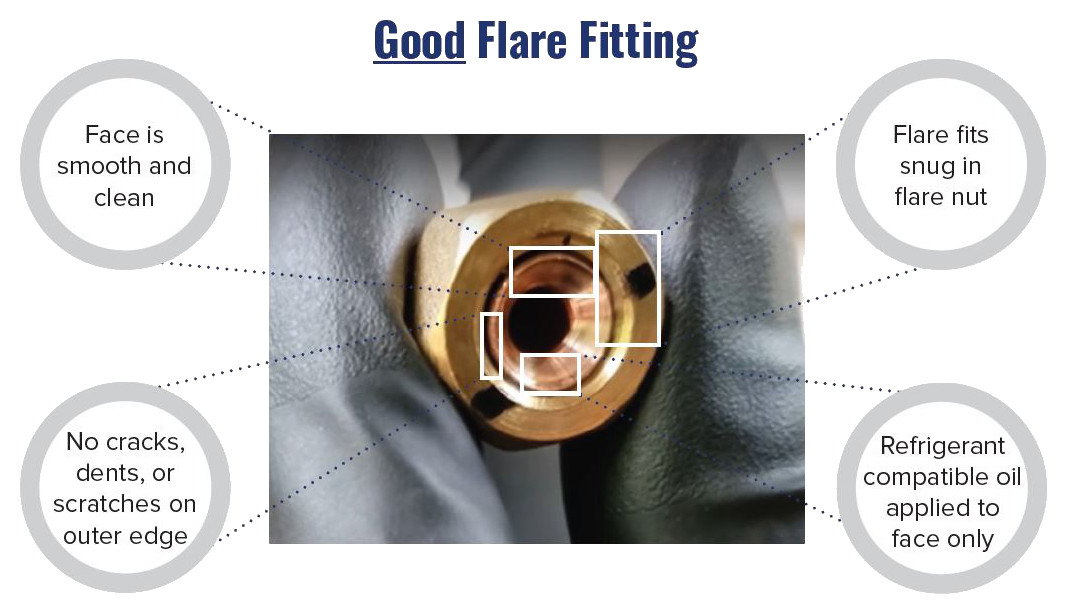
Flare Flitting
Creating properly fitted refrigerant tube connections can reduce maintenance call-backs, making for fewer leaks and better installations. To improve installations, use these procedures and information to know what to look for and do when installing and connecting refrigerant tubing.
